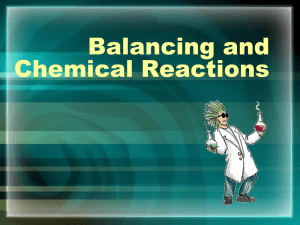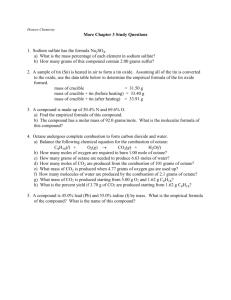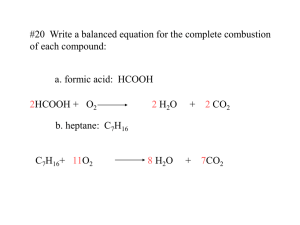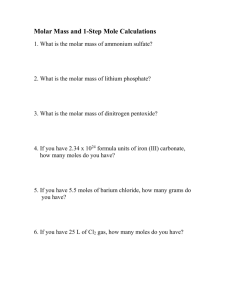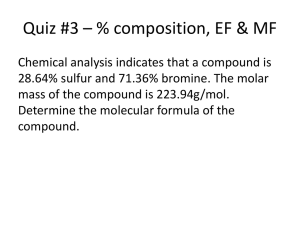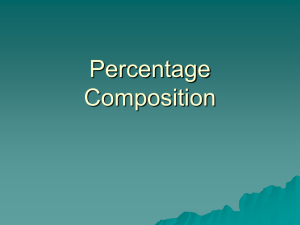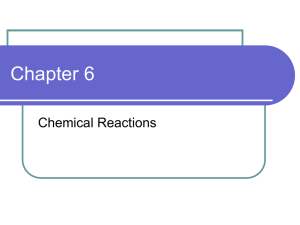Stoichiometry
advertisement
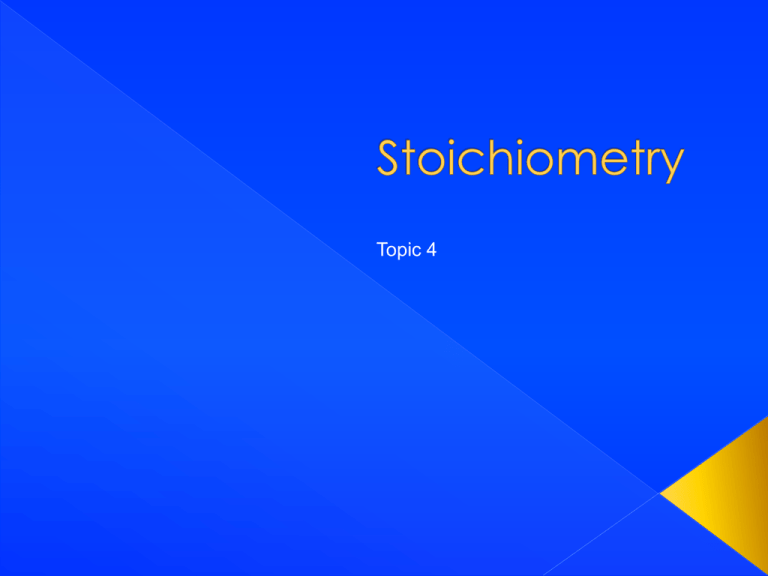
Topic 4 Reactants chemically change into products must be balanced use symbols to indicate states on AP exam, all equations are written as net ionic (have to know solubility rules) CO2(g) + 2NH3(g) + H2O(l) 2NH4+(aq) + CO32-(aq) Balance the following reaction: H2SO4(aq) + NaHCO3(s) CO2(g) + Na2SO4(aq) H2O(l) + Combination/synthesis – multiple reactants come together to form one product 2Na(s) + Cl2(g) 2NaCl(s) Decomposition – one reactant “falls apart” into multiple products MgCO3(s) MgO(s) + CO2(g) Combustion – compound reacts with oxygen (usu. from the air) C2H5OH(l) + 3O2(g) 2CO2(g) + 3H2O(g) We don’t use “single replacement” any more (more on that later) We also don’t use “double replacement”, they are called precipitation reactions (more on that later, too) Avogadro’s # = 6.02 x 1023 mole = amount of a substance that contains 6.02x1023 “things” molar mass = mass of 1 mole of a substance (numerically the same as atomic mass, but measured in g/mol) percentage by mass of each element in a compound Divide the mass of an element in a compound by the molar mass of the compound and multiply by 100. What is the %comp of each element in Na2CO3? simplest ratio of elements in a compound › for ionic compounds this IS the actual formula › for molecular compounds it could be the formula or it may need to by multiplied by some number to equal the actual formula start with %comp, convert to grams, then to moles, then to simplest ratio this is what your lab will be based on… What is the empirical formula of a compound containing 68.4% chromium and the rest oxygen? Molecular formulas are multiples of the empirical formula if the molar mass of the compound is known, the MF can be determined from the EF… A compound containing only carbon, hydrogen, and oxygen is 63.16% C and 8.77% H. It has a molar mass of 114 g/mol. What is its empirical formula and molecular formula? When a compound containing C, H, & O is completely combusted, all of the C becomes CO2 and all of the H becomes H2O. EF can be calculated from the amounts of products… A 3.489 g sample of a compound containing C, H & O yields 7.832 g of CO2 and 1.922 g of H2O upon combustion. What is the simplest formula of the compound? Ionic compounds form hydrates with water molecules (ex. sodium thiosulfate, decahydrate = Na2S2O310H2O) When hydrates are heated, the extra water molecules are evaporated off. Can calculate how many water molecules are in a hydrate by comparing the masses before and after heating (this will be another lab) When 21.91 g of a hydrate of copper (II) sulfate is heated to drive off the water, 14.00 g of anhydrous copper (II) sulfate remain. What is the formula for the hydrate? Must have a balanced reaction Pay attention to sig figs Keep it organized!!! How many moles of octane will burn in the presence of 37.0 moles of oxygen? How many grams of carbon dioxide are obtained when 695 g of octane are burned in atmospheric oxygen? In a chemical reaction with multiple reactants, one will be completely used up (the limiting reactant) and the others will be left over (the excess reactants). Involves lots of steps and the process is key to getting these right. 255 g of octane and 1510 g of oxygen gas are present are the beginning of a reaction that goes to completion and forms carbon dioxide and water according to the following equation. 2C8H18(l) + 25O2(g) 16CO2(g) + 18H2O(g) a) What is the limiting reactant b) How many grams of water are formed when all of the limiting reactant is consumed? c) How many grams of excess reactant is consumed? d) How many grams of excess reactant is left unreacted? Theoretical yield = calculated amount of product that should be formed Actual yield = amount of product that is actually formed in the lab, almost always less than the theoretical yield Percent yield = comparison of theoretical to actual yield (AY/TY) x 100%


